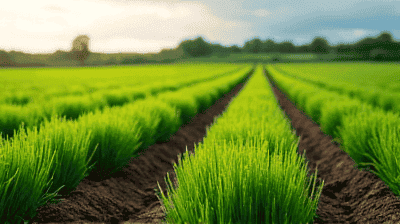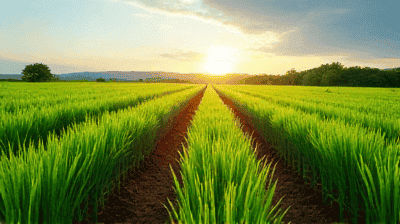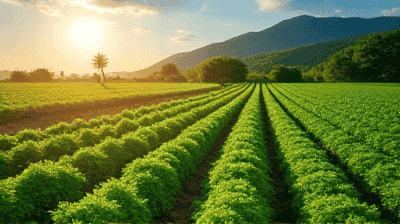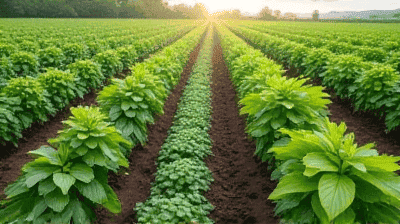
Soil is one of the most valuable resources on our planet, providing essential nutrients for crops, supporting biodiversity, and playing a critical role in water filtration. However, soil erosion and carbon loss pose significant threats to soil health and agricultural productivity. As the global population continues to rise, and climate change accelerates, we must implement sustainable agricultural practices that protect and enhance our soil resources. One of the most effective strategies for addressing these challenges is the use of cover crops.
Soil erosion refers to the removal of the topsoil layer, which is rich in nutrients and organic matter, due to natural forces like wind and water, and human activities such as farming and deforestation. Erosion can lead to significant ecological and economic consequences, including:
Loss of Nutrient-Rich Soil: The topsoil layer is critical for growing healthy crops. Its removal reduces soil fertility and productivity.
Sedimentation: Eroded soil often ends up in waterways, leading to sedimentation that can harm aquatic ecosystems and reduce water quality.
Increased Runoff: Eroded fields have less vegetation to absorb water, leading to higher runoff rates, which can contribute to flooding and further erosion.
Desertification: In severe cases, persistent soil erosion can lead to desertification, where land becomes increasingly unproductive and unable to support plant life.
There are several factors that contribute to soil erosion, including:
Water Erosion: Rainfall can dislodge soil particles, especially on slopes, leading to sheet erosion, rill erosion, and gully erosion.
Wind Erosion: In arid and semi-arid regions, strong winds can lift and transport loose soil particles, particularly from bare or poorly-covered fields.
Land Use Practices: Practices such as monoculture, overgrazing, and clear-cutting can weaken soil structure, making it more susceptible to erosion.
Soil Degradation: Compaction, loss of organic matter, and nutrient depletion can lead to erosion-prone soils.

Soil carbon plays a crucial role in maintaining soil health, fertility, and overall ecosystem functioning. It comprises organic matter, including decomposed plant and animal material, and is a critical component of soil structure. Soil carbon enhances soil's ability to retain moisture, supports beneficial soil organisms, and improves nutrient availability.
Carbon loss from soil can occur through various mechanisms, including:
Soil Erosion: As topsoil is eroded, carbon-rich organic matter is lost, drastically reducing soil carbon levels.
Land Use Change: Converting forests and grasslands to agricultural land often results in the release of stored soil carbon.
Conventional Farming Practices: Practices such as tillage and the use of synthetic fertilizers can lead to a decline in soil organic matter and carbon.
Climate Change: Increased temperatures and altered precipitation patterns can affect soil carbon sequestration and enhance decomposition rates of organic matter.
Cover crops are plants that are grown primarily to protect and improve soil health rather than for direct harvest. They are typically sown during the offseason or alongside cash crops to provide numerous environmental benefits. Common cover crops include legumes (such as clover and vetch), grasses (like rye and oats), and brassicas (such as radishes and mustard).
Cover crops offer a multitude of benefits for soil health and agricultural sustainability:
Erosion Control: Cover crops help to anchor the soil with their root systems, reducing the risk of erosion by stabilizing the soil surface.
Improved Soil Structure: The roots of cover crops improve soil aggregation and porosity, promoting better water infiltration and reducing compaction.
Carbon Sequestration: Cover crops capture carbon dioxide from the atmosphere through photosynthesis and store it in the soil as organic matter, contributing to carbon sequestration efforts.
Nutrient Cycling: Some cover crops, particularly legumes, can fix atmospheric nitrogen, enriching the soil with this essential nutrient.
Weed Suppression: Dense cover crop growth can outcompete weeds for sunlight, moisture, and nutrients, reducing the need for synthetic herbicides.
Habitat for Beneficial Organisms: Cover crops provide habitat and food for beneficial insects and soil organisms, enhancing biodiversity within the ecosystem.

The root systems of cover crops play a critical role in preventing soil erosion. As these plants grow, their roots penetrate the soil, creating a network that holds soil particles together. This root structure helps to:
Stabilize Soil During Rainfall: The roots absorb water and reduce runoff, which can dislodge soil particles during heavy rains.
Align Soil Particles: Roots create channels in the soil, improving its structure and reducing erosion potential.
Enhance Soil Aggregation: The organic matter from decaying cover crops promotes soil aggregation, resulting in a more resilient soil structure less prone to erosion.
Cover crops provide ground cover, which is essential for preventing soil erosion. When the ground is covered, the surface of the soil is protected from the direct impact of raindrops, which can displace soil. Benefits of surface coverage include:
Reduced Splash Erosion: By dampening the impact of raindrops, cover crops reduce splash erosion, which can displace soil particles and create small gullies.
Protection Against Wind: Cover crops can also reduce wind erosion by acting as a barrier, minimizing the exposure of bare soil to strong winds.
Enhanced Soil Moisture Retention: Covered soil retains moisture better, reducing the risk of drying and cracking, which can promote erosion.
Cover crops contribute to carbon sequestration by increasing soil organic matter through the following processes:
Root Biomass: As cover crops grow, their roots add organic material to the soil upon decomposition, increasing carbon storage.
Above-Ground Biomass: The plant residues left on the soil surface after cover crops are terminated provide additional organic matter that contributes to soil carbon levels.
Microbial Activity: The presence of cover crops enhances microbial activity in the soil, promoting the breakdown of organic matter and the formation of stable organic carbon compounds.
Cover crops play a significant role in capturing atmospheric carbon dioxide and storing it in the soil. Through photosynthesis, cover crops absorb CO2 and convert it into organic carbon compounds. Key points regarding carbon capture include:
Increased Biomass Production: The growth of cover crops during the offseason creates additional biomass, resulting in more carbon captured and stored in the soil.
Diverse Cover Crop Mixes: Using a mix of cover crops can enhance biomass production and, consequently, carbon capture, as different species contribute varying growth patterns and root systems.
Chain of Carbon Storage: The carbon that is captured through cover crops is then stored in the soil, where it can remain for extended periods, mitigating the impact of climate change.

When selecting cover crops, farmers should consider several factors to ensure that they are appropriate for their specific conditions and objectives:
Climate and Soil Type: Different cover crops thrive in different climates and soil types. Farmers should choose species suited to their local conditions.
Growing Season: Understanding the growing season is crucial for selecting cover crops that will be successful in terms of establishment and growth.
Desired Benefits: Farmers should identify the primary objectives for using cover crops, whether that be soil erosion control, carbon sequestration, or nutrient enhancement.
Compatibility with Cash Crops: Some cover crops may compete with cash crops for resources. Therefore, selecting compatible species that won't interfere with main crop growth is necessary.
Legumes: Common legumes like clover, vetch, and peas can fix nitrogen in the soil and enhance nutrient availability for subsequent crops.
Grasses: Species such as rye, oats, and barley provide excellent ground cover, with deep root systems that prevent soil erosion.
Brassicas: Cover crops like radishes and mustards can improve soil structure and suppress weeds through their rapid growth.
Mixes: Utilizing a mix of cover crops can maximize ecological benefits by combining the strengths of different plant types. For instance, pairing legumes with grasses can enhance nitrogen fixation while providing robust soil cover.
To effectively implement cover crops, farmers can adopt the following strategies:
Sequential Cover Cropping: After the main crop is harvested, farmers can sow cover crops immediately to protect the soil during the off-season.
Intercropping: Some cover crops can be planted alongside cash crops during the growing season to provide additional benefits without compromising main crop yields.
Termination Timing: Proper timing of cover crop termination is crucial to optimize benefits. Farmers should consider factors such as cash crop planting schedules and soil moisture retention.
Utilizing Equipment: Farmers may need specialized equipment for planting and terminating cover crops efficiently. Investing in suitable tools can facilitate successful implementation.
Numerous farmers worldwide have successfully adopted cover cropping practices, demonstrating the benefits of this sustainable strategy:
Case Study: The Midwest USA: Many farmers in the Midwest have integrated cover crops into their rotation, leading to improved soil health, reduced erosion, and increased yields over the long term.
Case Study: Organic Farms: Organic farms often utilize cover crops as part of their soil management strategies, enhancing biodiversity, soil quality, and the health of ecosystems.
Case Study: Agroecological Practices: Farmers practicing agroecology incorporate cover crops to achieve sustainable production, often enhancing resilience to climate impacts while improving soil carbon stocks.
Many farmers may lack experience or knowledge regarding the implementation of cover crops. Education through workshops, extension programs, and local organizations can help bridge this gap. Sharing success stories and best practices can encourage wider adoption.
While cover crops provide long-term benefits, there may be initial costs associated with seeds, planting, and equipment. Farmers should explore cost-sharing programs, grants, and financial assistance to help mitigate upfront expenses.
Effective management of cover crops is essential to maximize benefits. Farmers should monitor cover crop growth and adjust management practices as needed. This includes managing cover crop termination to avoid competition with cash crops.
Governments can play a vital role in promoting cover crop adoption by creating supportive agricultural policies. This includes:
Incentives for Cover Cropping: Financial incentives and grants can encourage farmers to implement cover cropping practices.
Research Funding: Supporting research on cover crops can lead to new recommendations and strategies tailored to various farming systems and climates.
Education Programs: Providing educational resources and training for farmers will empower them to adopt best practices for cover cropping.
Integrating cover crops into conservation programs can enhance their adoption. This includes:
Technical Assistance: Offering technical support to farmers can help them successfully implement cover cropping strategies.
Funding for Conservation Practices: Providing funding for cover crops can incentivize farmers to adopt practices that protect soil and promote sustainability.
As awareness of the benefits of cover crops increases among farmers, researchers, and policymakers, we can expect to see broader adoption of these practices. Cover cropping will play a crucial role in addressing soil erosion and carbon loss while enhancing soil health.
Ongoing research into cover cropping systems and the development of new technologies will continue to improve our understanding of their impacts. Innovations in seed varieties, planting methods, and management practices will further enhance the effectiveness of cover crops.
Cover crops hold promise not only for agricultural practices in developed countries but also for smallholder farmers in developing regions. With appropriate support and resources, cover cropping can help farmers in diverse settings enhance resilience to climate change and improve soil health.
Cover crops represent a powerful tool in the fight against soil erosion and carbon loss. By promoting soil health, enhancing crop resilience, and contributing to carbon sequestration, cover crops offer a sustainable strategy for addressing some of agriculture's most pressing challenges. As we continue to seek solutions for a sustainable food future, the adoption of cover cropping practices will be essential in creating more resilient, productive, and environmentally friendly agricultural systems.